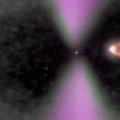

Haunting the Cepheus Flare
Image Credit & Copyright: Leo Shatz
Explanation: Spooky shapes seem to haunt this dusty expanse, drifting through the night in the royal constellation Cepheus. Of course, the shapes are cosmic dust clouds visible in dimly reflected starlight. Far from your own neighborhood, they lurk above the plane of the Milky Way at the edge of the Cepheus Flare molecular cloud complex some 1,200 light-years away. Over 2 light-years across and brighter than most of the other ghostly apparitions, vdB 141 or Sh2-136 is also known as the Ghost Nebula, seen at the right of the starry field of view. Inside the nebula are the telltale signs of dense cores collapsing in the early stages of star formation. With the eerie hue of dust reflecting bluish light from hot young stars of NGC 7023, the Iris Nebula stands out against the dark just left of center. In the broad telescopic frame, these fertile interstellar dust fields stretch almost seven full moons across the sky.
Tomorrow’s picture: of light and shadow
仙王火焰分子云的幽灵
影像提供与版权: Leo Shatz
说明: 夜间漂泊在仙王座里的这些幽灵状天体,看来像是在这片美丽星野里出没的幽魂。其实,这些奇形怪状的天体,是正在反射微弱星光的宇宙尘埃云。这些离太阳系颇远的星云,位银河盘面上方的仙王火焰分子云复合体之边缘,离我们约莫有1,200光年远。影像中,位在星野右侧,大小超过2光年,比其他幽灵状云气要明亮的vdB 141,亦称为Sh2-136和鬼魂星魂。这团星云内的致密云核,展现出处在恒星形成阶段的初期、正在发生塌缩的特征迹象。影像中左方在暗色环境中极为醒目的天体,则是因尘埃反射炽热年轻恒星的星光,而带着魅丽泛蓝色泽的鸢尾花星云(NGC 7023)。在这张广袤的望远镜影像里,这些浓密的星际尘埃在天空绵延了将近7个满月的宽度。 (Cepheus Flare 仙王火焰分子云)
明日的图片: of light and shadow



